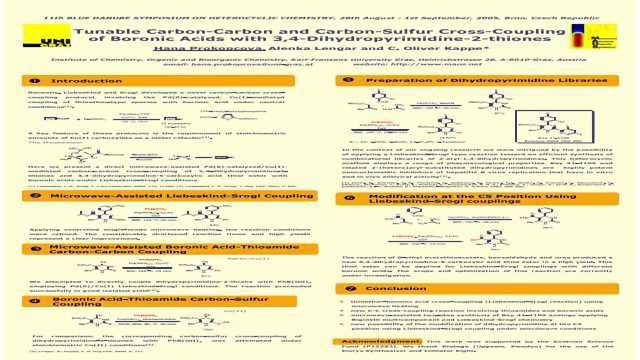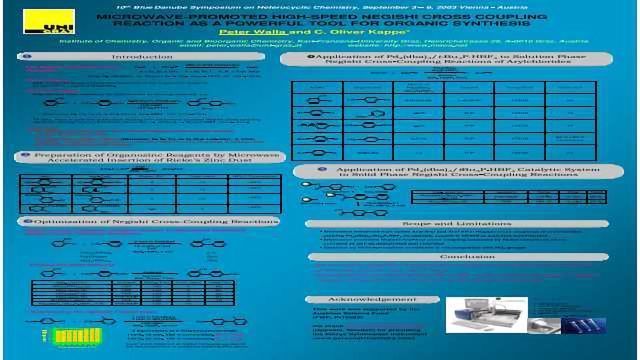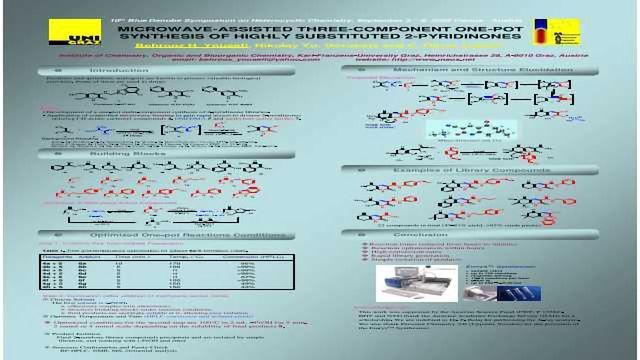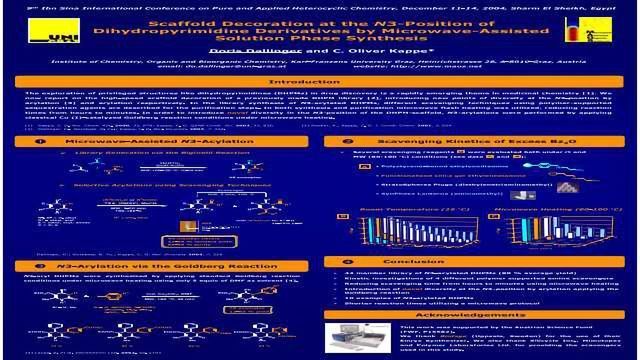Latest Posters

Poster
Computational Model of the Anthracycline-Binding Site in Carbonyl and Aldo-Keto Reductases: a Structural Basis for Designing Inhibitors
The aim of this work was to investigate the interaction mechanism of the anthracyclines with the cytosolic reductases. Predictive models have been constructed by means of a molecular docking study, that offer utility in guiding the rational design of inhibitors of reductase activity.

Poster
Applications of Laser Scanning Microplate Cytometry in High Content Screening
Traditional methods for High Content Analysis (HCA) use technologies such as flow cytometry and microscope-based imaging systems. Laser-scanning microplate cytometry has many advantages over these, and is more amenable for use in High Content Screening (HCS).

Poster
Tunable Carbon-Carbon and Carbon-Sulfur Cross-Coupling of Boronic Acids with 3,4-Dihydropyrimidine-2-thiones
Here we present a direct microwave-assisted Pd(0)-catalyzed/Cu(I)-mediated carbon-carbon cross-coupling of 3,4-dihydropyrimidine-2-thiones and 3,4-dihydropyrimidine-5-carboxylic acid thiol ester with boronic acids under Liebeskind-Srogl conditions.

Poster
Microwave-Promoted High-Speed Negishi Cross Coupling Reaction as a Powerful Tool for Organic Synthesis
The aim of this research was to develop high speed microwave assisted Negishi cross coupling reaction starting from arylchlorides and to extend Fu's catalytic system (Netherton, M. R.; Fu, G. C. Org. Lett. 2001, 3, 4295) Pd2(dba)3 / tBu3P.HBF4 to microwave promoted Negishi cross couplings in solution and solid phase employing arylchlorides.

Poster
Microwave-Promoted High-Speed Negishi Cross Coupling Reaction as a Powerful Tool for Organic Synthesis
The aim of this research was to develop high speed microwave assisted Negishi cross coupling reaction starting from arylchlorides and to extend Fu's catalytic system (Netherton, M. R.; Fu, G. C. Org. Lett. 2001, 3, 4295) Pd2(dba)3 / tBu3P.HBF4 to microwave promoted Negishi cross couplings in solution and solid phase employing arylchlorides.

Poster
Microwave-Assisted Three-Component One-Pot Synthesis of Highly Substituted 2-Pyridinones
Pyridone and quinolone analogous are known to possess valuable biological activities. The aims of this research were the development of a one-pot multi-component synthesis of 2-pyridinone libraries and the application of controlled microwave heating to gain rapid access to diverse 2-pyridinones utilizing CH-acidic carbonyl compounds 4, DMFDMA 5 and methylene active nitriles.

Poster
Label-free Profiling of Ligands for Endogenous GPCRs Using a Cell-Based High Throughput Screening Technology
The activation of GPCRs is known to lead to the dynamic translocation of multiple signaling molecules or molecular assemblies during its signaling cycle, and in many cases cytoskelatal reorganization. Such a movement and/or reorganization results in dynamic redistribution of cellular contents, equivalent to dynamic mass redistribution (DMR), which can be monitored online in living cells using Corning® Epic™ system – a label-free and non-invasive biosensor system.

Poster
Scaffold Decoration at the N3-Position of Dihydropyrimidine Derivatives by Microwave-Assisted Solution Phase Synthesis
In the library synthesis of N3-acylated DHPMs, different scavenging techniques using polymer-supported sequestration agents are described for the purification steps. In both synthesis and purification microwave flash heating was utilized, reducing reaction times from hours to minutes. In order to introduce novel diversity in the N3-position of the DHPM-scaffold, N3-arylations were performed by applying classical Cu (I)-catalyzed Goldberg reaction conditions under microwave heating.

Poster
Scalability of Heterocyclic Microwave-Assisted Transformations From Batch to Continuous Flow - A Case Study
Herein we present a case study on the small to large scale microwave-assisted synthesis of the DHPM 4 under batch and continuous flow conditions in monomode and multimode cavities.

Poster
Monitoring Translocation Activity of Transcription Factors and Nuclear Hormone Receptors Using EFC
Enzyme Fragment Complementation can provide data for analysis of protein translocation events in whole cells, with the added benefits of increased throughput, simplified luminescence detection, no antibody requirements and decreased assay costs.
Advertisement

